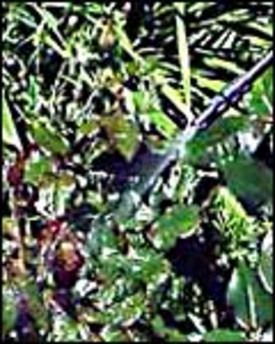|
However, many popular roses are also susceptible to three fungal diseases, whose names black spot, mildew, and rust are descriptive of their appearance on rose leaves. Here are steps to follow to keep the plants healthy and vigorous.
Plant disease-resistant varieties
Some roses are very susceptible to these fungal diseases, others are virtually immune, and many fall somewhere between. So the first line of defense is to select only disease-resistant varieties. Many rose reference books, such as Roses For Dummies, include this information.
Grow healthy plants
Plant roses in full sun in rich, well-drained soil. Soil pH is ideally between 5.8 and 6.2. If the pH is lower, add limestone. If it’s higher, add sulfur. Space plants about 3 feet apart to allow good air circulation, and mulch roots in summer to help maintain even soil moisture and to prevent competition from weeds.
Water regularly
Generally, you want water to reach everywhere within the plant’s root zone, which may be as deep as 18 inches and as wide as the crown of the plant. Get to know your soil and how water penetrates and travels within it. If the soil around your roses is dry to a depth of 4 inches, you should definitely water, but it’s best not to let it get that dry.
Water roots, not leaves
Wet leaves encourage some fungi, so avoid wetting them unless you are washing off dust or aphid infestations with a hose. Drip irrigation is better for watering roses than sprinklers.
Fertilize correctly with neither too much nor too little fertilizer. Rose plants that are either under- or overfed will be more susceptible to problems. One simple method is to buy a fertilizer packaged for roses and to follow the label directions.
Prune correctly
Different kinds of roses need different kinds of pruning. Most 3- to 5-foot-tall rose plants need to one annual pruning in early spring. At that time, remove any dead branches or twigs, as well as branches that crowd the center of the plant. Prune so that the pruned plant has a V or vase shape.
Inspect leaves
Visit roses regularly and check leaves for signs of disease. It’s best to wait until the leaves are dry, midmorning through afternoon, since we can unwittingly spread diseases by touching wet plants. If you notice signs of disease, remove affected leaves and apply a preventive spray as directed on product label.
Off-season care
In the fall, remove all fallen leaves on the ground below the plants, and dispose of them. In late winter or early spring, prune plants and apply horticultural oil to smother disease organisms that may have overwintered on branches. Spread a fresh layer of mulch to cover any disease spores that might be on the surface of the old mulch.
Spray remedies
Roses are so popular and widespread that many sprays are available to control their diseases. Here are common-sense remedies that you can start with:
Black spot causes black spots on leaves and stems. Remove all winter prunings, a common source of reinfection. In early spring before growth begins, spray a combination of dormant oil and lime sulfur.
Powdery mildew causes a grayish white fuzz on new leaves and flower buds. It spreads on dry leaves, usually during periods of low rainfall and warm, humid nights. Use a spray containing potassium bicarbonate, basically baking soda but in a form that is more plant friendly.
Another kind of mildew, downy mildew, causes round, dark purple spots with yellow edges. It’s more serious than powdery mildew but less common. It needs moisture to spread, so control it by watering only in early morning.
Rust causes rust-colored spots on leaf undersides and is most common during periods of warm days and cool nights. As for black spot, remove winter prunings and spray dormant oil combined with lime sulfur.
Credit: National Gardening Association





























